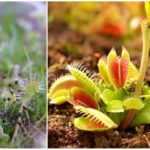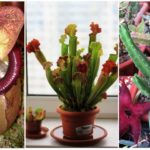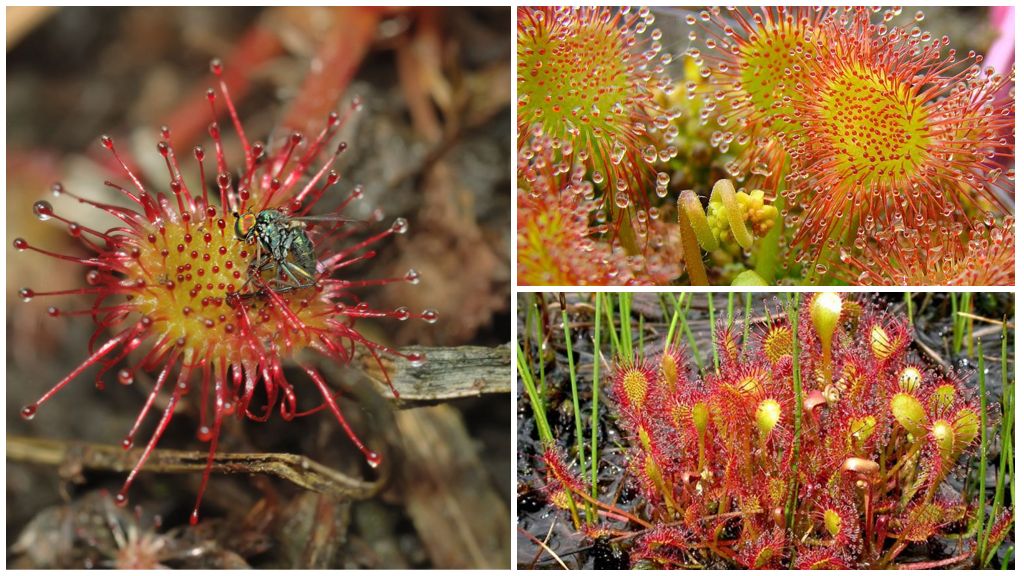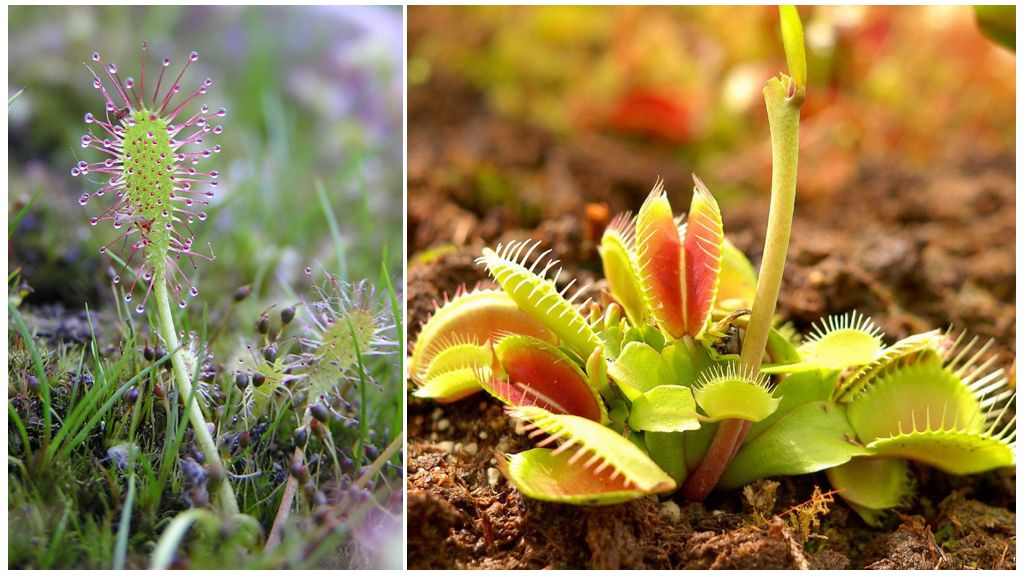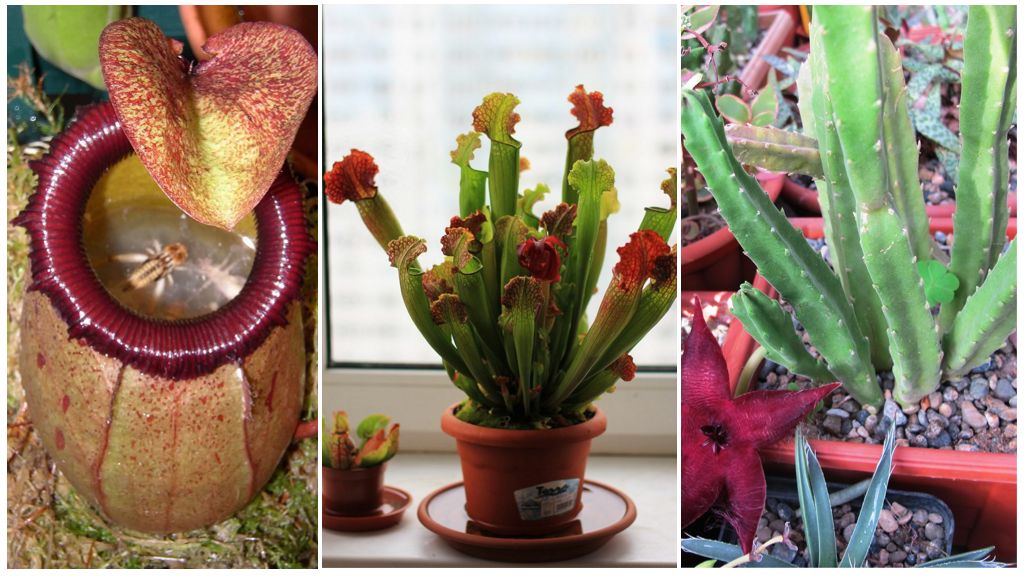Name, description and photo of the plant that eats flies
Content
- All-round sunflower
- Sundew, English and Venus flytrap
- Predator plants: nepentes, sarracenia and stapelia
Flies - annoying creatures and not amenable to any tricks. The continued use of chemicals to kill these insects is not very beneficial for humans and harms the environment. Sometimes to protect against pests, you can use a plant that eats flies.These species of flowers developed independently of each other, adapting to feed on living organisms due to the scarcity of soils in the places of growth. Basically, these are marshy lowlands, where trace elements are almost absent in the ground.
Types of Flycatchers
In total in the world there are about 630 species of predatory plants belonging to 19 genera. In Russia, there are 18 species growing from 2 families: Rosyankov and Puzyrchatkov.
Bubbly predatory everything, but they are not of practical interest. At home, they are very difficult to plant, because it is aquatic plants, devoid of roots. On the surface of the water they are held due to the large number of trapping bubbles located in the leaves. Insect, getting inside the bubble, can not get out of there.
Much more interesting Rosyankovye. This ground plants, which, if desired, can be bred at home. The name of the plants of the Rosyankov family comes from their method of catching insects.
On a note!
Large sundew can catch not only a flybut even a dragonfly.
What do sundews look like
These are perennial plants with a tuber-like thickened root. There are sundews on almost all types of soil:
- sandstones;
- swamps;
- in the mountains.
The flowers of these plants are inconspicuous, and on the leaves are long, thin hairs. On the tips of the hairs, small droplets of sweet liquid are released, similar to the dew that has fallen out. Hence the common name "sundew".
Sweet syrup plant attracts flies and male mosquitoes, which sit on the leaves to eat. It is necessary to touch the fly hairs, it will stick to the sheet. Syrup is not only sweet, but also viscous. The plant slowly begins to twist the leaf around the fly. After complete folding, the leaf remains in this position until the plant completely digests the prey.
In Russia, several species of dews are common, including the type species.
All-round sunflower
Perennial flower that eats flies. Type species, which gave the name to the entire genus of dews. Distributed throughout the Eurasian continent. It prefers swamps, can grow on peatlands and wet sands.
A round-leaved sundew can safely be called a long-liver - it lives for several decades. But due to poor nutrition, the sundew grows very slowly and does not grow large.
Leaves grow from the rosette and are located on the ground.Glandular hairs 4-5 mm long are located on small round leaf plates. These hairs emit droplets of a liquid similar to dew.
It feeds on sundew round-leaved not only flies. When an insect is grazed by a sensitive hair, the leaf folds and the hairs dig into the cover of the invertebrate.
Interesting!
Eating insects occurs with the help of those very liquid droplets that are actually a digestive enzyme.
English sundew
Perennial plant, common not only in Eurasia, but also in North America. In some regions of Russia entered in the Red Book.
This is another flower that eats flies. Unlike sundews, the English ration is based on flying invertebrates, including dragonflies. The leaves of the English sundew are directed upwards. Length of leaf blade 1.5-3 cm. Width 5 cm. The leaves are covered with red glandular hairs. When a fly is caught, a piece of an English sundew is wrapped around the insect. What a flower that eats a fly in the midst of a process looks like in the photo can be seen below.
Venus flytrap
This native of the North American continent is often bred at home as an ornamental plant.
Interesting!
The Latin name of the flower muscipula is translated as "mousetrap."It is believed that this was the mistake of the botanist who described the plant. But confirmation of this hypothesis is missing. The name "Venus" is given in honor of the goddess of love.
It is a herbaceous plant with 4-7 leaves that grow from a rosette. Bulbous flower stalk. The length of the leaves is 4-7 cm and depends on the season. Longer leaves grow after flowering.
The leaves of the flycatcher resemble flowers. They are oval shaped and red in color. But this is only a device for luring invertebrates.
The name "flycatcher" is also untrue, just like "mousetrap". Venus flytrap does not apply to flowers that catch flies. These diptera are random prey, occupying only 5% in the diet of a predatory plant. The bulk of the diet of this plant is invertebrates crawling on the ground. One third of them are ants.
Even a sheet of flycatcher looks like a trap. It is almost smooth inside and has sensitive hairs around the edges. If the hairs are disturbed at least 2 times with an interval of no more than 20 seconds, the sheet will begin to close the edges.
The digestion process takes an average of 10 days.Then the leaf opens, "throws out" the empty chitinous shell and expects the next prey. During the life of a single trap leaf, an average of 3 insects fall into it.
On a note!
The habitat of Venus flytrap in the homeland - swamps. This flower can easily live on the window sill or in the garden if it has a sufficiently moist earthy lump. Drying for the flycatcher is bad.
Jugs
Plants, some leaves of which look like bright flowers of a jug-shaped form. But even about these plants it cannot be said that they use flowers of the trap. As traps they also have leaves-tubes, at the bottom of which liquid accumulates. Flies fly to the bait and drown in it. Since in fact it is a concentrated digestive enzyme.
The jugs are painted in various bright colors, while the real flowers of the jugs are small and inconspicuous.
Nepentes
The inhabitant of tropical humid regions. The length of the nepentes, depending on their type, is 2.5–50 cm. The largest ones can catch and digest a small mammal. Or join with the animal in a symbiosis.Large Nepenthes lowii, except insects, uses as a source of organic dung of mountain stupa. And the animal feeds on nectar.
Interesting!
For the sake of convenience, the entire jug-sheet jug design is reinforced to withstand the extra weight.
Sarracenia
The family consists of 10 species. the trap for flies is a rolled-up funnel-shaped leaf growing from the root. The plant is native to North America. Sarrasenia was grown as a houseplant in pre-revolutionary Russia. It grows well in pots.
Breeders have already developed new cultivated varieties of sarration, which can be grown indoors. With good care you can achieve flowering sarratsenii.
Stapelia
A plant that is mistakenly considered a cactus. It blooms with large, dark red flowers that exude the smell of rotten meat. But to use it for the destruction of flies is impossible, except to thin out their offspring.
On a note!
Cacti that eat flies in nature does not exist.
The purpose of the stocks is to attract pollinating flies, and not to catch insects. Stapelia lures to itself meat flies. Necrophages, arriving at the smell of carrion, try to lay eggs in a flower. In the process of reproduction they get dirty in the pollen of the flower and transfer it to the next slipway. When breeding the stocks as a houseplant, pollen is wasted as eggs fliessince the flower of the stocks keeps alive for about 24 hours, after which it dies. The larvae that did not have time to hatch die along with it.


